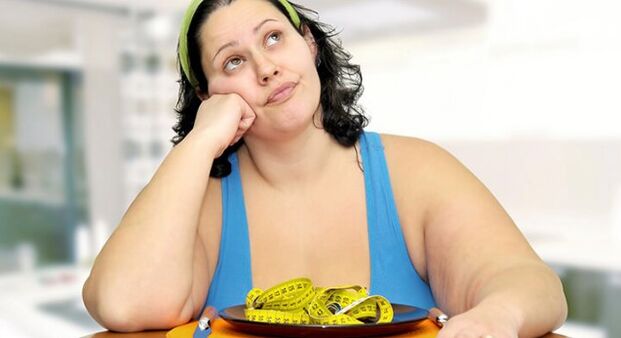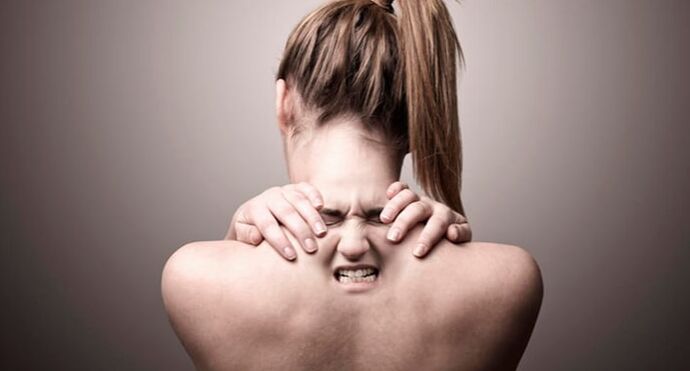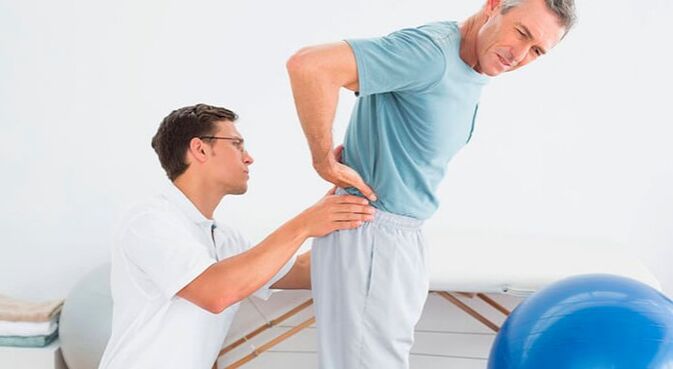Osteocondrosis is a pathology that is known to 40% of the population under the age of 35-40, almost 90% in old age. Even in adolescents, signs of osteochondrosis are presented - a reduction in the height of the discs, the pain and the discomfort of the spine. If you start treating the disease in the first phase before the disk is destroyed, the chances of stopping progression are very high.
What is osteochondrosis?

One or more vertebrae discs occur with osteochondrosis of the spine. The disease can occur in any class:
- Chest;
- Shein;
- Lumbar (lumbosac).
In severe cases, the degeneration of vertebrates is observed in the column as a whole, which causes human disability. So what is this disease - osteochondrosis? The pathology is associated with a gradual, constant and gradual violation of the nutrition of hyaline cartilage on intervertebral discs, which results in their position, shape and crack. A person experiences severe pain syndrome, and the functions of the entire muscle bone system deteriorate.
What is osteochondrosis for its consequences? If you do not treat treatment, the vertebrae will be squeezed, the cracks between them will decrease and the plates will crumble. This leads to damage to the nerve roots, the damage to the spinal cord and the harmful work of the internal organs. Bone osteophytes appear on the edges of the plates - growths that cause even greater pain. The consequences of spinal disease are very serious.
The main causes of osteochondrosis
Scientists came to conclusions and studied osteocondrosis that this disease is a consequence of man's clarity, so it is exposed to most people. High daily loads of the spine, deterioration of vascular functions, inferiority of nutrition and aging of the body are the main causes of osteochondrosis. The following factors are considered by the situation:
- The frequent body of the body (for example, curved seat at the desk, wearing a bag on the shoulder);
- Sleep on soft mattresses, pillows;
- Flat legs, deformation of the foot;
- Metabolic diseases;
- Overweight, bringing increased loads on the spinal column;
- Hypodynamia;
- Posture disorders;
- Multiple pregnancy;
- Long smoking experience;
- Instability of the vertebrae.

Injuries, heavy physical activity greatly exacerbates the development of osteochondrosis of the spine. Therefore, athletes, physical work staff, the lower back of osteocondrosis - a very "popular" problem. The heritage also plays an important role in the pathogenesis of the syndrome - if parents have serious problems with their backs at a young age, the child is at great risk of getting the spine disease.
Psychosomatics of osteochondrosis
The psychosomatic causes of pathology are new directions in search of prerequisites for its formation. Psychosomatics involves the effects of psychological factors on the development and course of physical illness. The relationship between physical and mental problems is indeed crowded and, according to their appearance, a healthy person may suffer from regular pain. In the case of osteochondrosis, some people have no objective cause of pathology, but it goes on.
Up to 30% of patients after visiting a doctor indicate problems such as as follows:
- Constant stress;
- Chronic experiences;
- Nervous surge;
- Family problems;
- Conflicts;
- Moral breakdown.
The stages of illness
The intervertebral dial consists of liquid and solid parts. The first is in the center that represents a core that gives flexibility. The seed is surrounded by a strong ring from above. At the fluid structure, all pathological changes in the plate, which later spread into the shell, begin.
In medicine, four stages of osteochondrosis are distinguished. This refers to the conditional unity of the pathology with the severity of the spinal violation:

- The first stage of osteochondrosis. The amount of moisture on the plate is dry. The destruction does not yet occur, but after the seed is severely dry, the fibrous ring appears in the micro fractures. At this stage of the disease, symptoms are usually missing.
- The second phase of osteochondrosis. The height of the plate begins to decrease, which means gradual attachment of symptoms and progress of pathology. In the spine, the distance between the individual segments is reduced, so the ligaments descend. At this stage, many patients cause the disease to slip the vertebrae - spondylolistz. Pain, discomfort in the case of aggravations, painful pain can also be present in remission.
- The third stage. The spine osteochondrosis at this stage results in severe pain syndrome as the complications develop. Most often this is the protrusion of the disc, less often - the spinal joints of arthrosis (degeneration), the subluxation of the vertebrae. The pain is complemented by the mobility of the affected spine segment.
- Fourth section of osteochondrosis. The spinal column begins to adapt to the new conditions of existence, trying to repair the vertebrae to protect the final destruction. To do this, the osteophytes grow. Pain can be rough due to injury to nerve endings.
Symptoms of osteochondrosis
The first signs of osteochondrosis usually begin in the initial stages when there is no pain. In the neck, lower back, you can hear a crunch (this is a violation of the power of the plate, it dehydration) by moving in the chest region. In addition, when overloaded, working in an uncomfortable position, a person can note the stiffness of the back or neck muscles. On one or two sides, there will be a "stone", which is uncomfortable, causing burns and irritation.
Subsequently, the symptoms of osteochondrosis become more obvious. At rest, you may feel normal, but the weight of the weights, the dream of an unpleasant cushion, can provoke these phenomena:
- Painful pain;
- Species;
- Numbness of hands (with cervical injury);
- Feeling of stiffness;
- Forced decrease in movements;
- Muscle spasm;
- Holidays;
- Increased pressure;
- A violation of posture.

During the overload of the patient's spine, osteochondrosis gives more pronounced signs and symptoms. The pain occurs on the shoulders, puts it on its hands, elbows, headaches. With osteochondrosis of the cervical spine, the ear, dizziness, spinal artery syndrome develops, and vision is disturbed. Over time, muscle atrophy does not occur without the treatment of osteochondrosis, the skin is pale. The course of cardiac catologies can worsen and the work of the liver, gallbladder and gastric intestinal tract is interrupted.
What does the pathology lead to?
The consequences of this disease are always unpleasant and cause an increase in pain. They are in the case of osteochondrosis:
- Disc rise;
- The disk prolaps and hernia;
- Radiculitis, isias, lumbago;
- Kyphosis, Skoliosis.
The danger of humans is highly dependent on the type of hernia for osteochondrosis of the spine. Front, back, sides and the most dangerous are the rear hernia - they can squeeze the spinal cord. In the lumbar segment of the spine, the hernia is most common, especially between 4-5 vertebrae.
Lumbar osteochondrosis can cause very unpleasant symptoms - shelters (Lumbago). The Lumbago pain is burning, sharp, unbearable, very difficult to bear. The reason for this is the nerve because the patient is damaged by a bundle of neuro. Particularly dangerous for horse tail syndrome is osteochondrosis when a person has a large bundle spine nerve. As a result, the intestinal functions, the bladder, and even the paralysis of the legs can occur.

Signs of osteochondrosis are often placed on severe muscle atrophy. If the muscles are not involved in the body for a long time, the spine movement is limited, then the individual fibers will weaken. As a result, the patient can become a person with a disability that is chained. Cervical osteochondrosis is also very dangerous as the hernia in this segment may violate the blood supply to the brain. At this stage, there is a risk of visual impairment, swallowing, speech and other brain functions.
Diagnosis of the disease
You should think about treating it with independent recognition of the signs of osteochondrosis. Because the lesion of the spine can achieve different stages, the treatment of osteochondrosis is also unequal. It is important that the correct diagnosis is made so that the therapy is properly selected.
Due to the widespread prevalence of the disease and the presence of characteristic symptoms, the doctor will be able to diagnose during preliminary examination. But to distinguish osteochondrosis, we make the following diagnosis of other diseases of the back and internal organs:
- X -tumor of the spine. It helps to identify the height of the discs, the degree of thinning, and the presence of osteophytes.
- CT, MRI. It is more advantageous during the test. With this disease, the severity of nerves, soft tissues and the smallest protrusions show the determination.
In osteochondrosis, laboratory tests do not play the most important role, but overall analysis requires biochemistry to exclude the inflammatory process, rheumatic injuries of bones, joints, and joints. To study muscle function, the physician performs a number of physical tests and produces duplex, electromiography to clarify the work of blood vessels and nerves.
Treatment of osteochondrosis
If the symptoms and treatment of osteochondrosis are determined, it is not worth delaying the therapy - the disease is moving rapidly. In the early stages, gymnastics is usually recommended, massage to strengthen the muscles - that will be enough. In the remaining stages of osteochondrosis, drug treatment and sometimes surgery will be needed.
Relening of the pain is the least unpleasant sign of the disease -uses non -steroid anti -inflammatory drugs. They cannot cure osteochondrosis, but it is always prescribed before exercise therapy to relieve symptoms. In severe cases, drugs are administered in injections, but more often are recommended for 7-14 days tablets and locally in the form of ointments.
If a person has severe painful syndrome in the spine, it is injected directly into the harmful zone with glucocorticosteroid injections.
Treatment of osteochondrosis is also done with the following means:
- B Vitamins B. B. help improve the nerve conductivity of the spine.
- Chondroprotectors. They nourish the intervertebral cartilage and strengthen the plates.
- Musorelaxants. Reduce the strength of muscle cramps for osteochondrosis.
- Vascular drugs. Optimizes blood circulation in the spine.
If osteochondrosis is developed, only chondroprotectors provide anesthesia and pathogenetic treatment, they are kept for 3-6 months. Other drugs have symptomatic effects and does not affect the course of osteochondrosis.
Physiotherapy and osteochondrosis

In the list of measures, such as the treatment of osteochondrosis, physiotherapy techniques necessarily include. Thanks to physiotherapy, the treatment of osteochondrosis will be more effective as the effect extends directly on the focus of inflammation. Physiotherapy relieves painful syndrome, eliminates cramps, improves blood microcirculation, and helps to remove clips from the nerves. The most popular methods are as follows:
- Electrophoresis. Treatment of osteochondrosis in this way allows relaxing, anti -inflammatory substances and anesthesia directly into the zones of the vertebrae, muscles, and ligaments.
- Ultrasound. It relieves unpleasant symptoms, anesthesia, creates the effect of vibration massage, and activates metabolism at a local level.
- Magnetic therapy. Varias or permanent magnetic fields eliminate the inflammatory process.
All types of physiotherapy should be performed by 10-15 procedures, while each contraindications must necessarily be taken into account.
Gymnastics and massage
Body practice therapy in the treatment of osteochondrosis plays a dominant role. Without practical therapy, it is not possible to form a strong muscle lace and the latter is required to maintain the patient's spine. In addition, gymnastics improves blood circulation in the spinal zone, improves metabolic processes and helps to rapidly remove decomposition products.
How to cure osteochondrosis with gymnastics? The complex is only selected separately and can only be performed in 1-2 stages without checking a doctor. In later stages, unnecessary, stronger movements can cause and confirm the problem. In 3 stages, all the exercises are done only in lying positions.
Massage is required to treat osteochondrosis. They don't do it in the acute phase - it causes excitement. But the correctly performed massage in the chronic stage, with osteochondrosis, is essential. During the seats, the muscles relax, the clamps are removed, and the nerves and blood vessels function normally. The massage is done only in gentle mode without sudden movements.

Prevention of pathology
In order not to conduct osteochondrosis surgery, it is important to carefully consider prevention measures:
- Do not allow hypodynamia. This disease can travel with energy load, but swimming, skis, charge only results in strengthening of muscles and whole health.
- Follow your posture. It is important to sit correctly at work and at home, gender and from childhood.
- Sleep on comfortable pillows. There are preventive pillows, with existing osteochondrosis, and many other therapists are used.
- Do not raise the weights. If necessary, sit down, get up the object, hold your back straight.
- Do hours regularly to strengthen your muscles. This is important for the neck muscles, the back, the pressure, the lower back.
- Wear comfortable shoes. Orthopedics do not allow the risk factor to overcome the vertebrae.
It is also important to eat well, do not smoke, enrich your diet with vitamins, consume more fluids - so the probability of pathology will decrease.






















